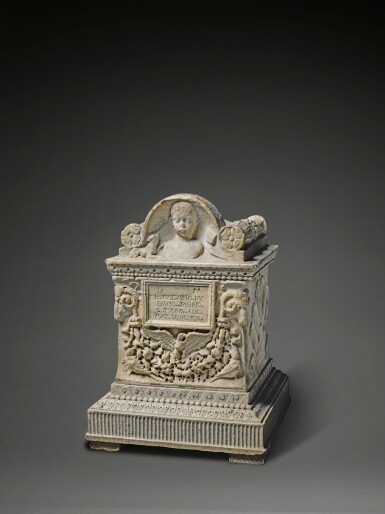LATE ROMAN MARBLE CINERARY URN 4th-5th century AD A carved marble casket, rectangular in plan with ledge feet, gabled lid with palmette to each corner; the lid with panels of reserved palmettes and tendrils, the body with an advancing gryphon to each short side, scene with reclining figures to each long side. 1.7 kg, 13cm (5 1/4"). Condition Fine condition, some surface accretion. Provenance From an important collection of a Mayfair gentleman; acquired from a Mayfair gallery before 1999. Footnotes The cinerarium was designed to be placed in a niche in a communal or family tomb, most commonly called a columbarium due to its likeness to a dovecote. It was in these tombs that relatives would come to perform rituals in honour of their dead ancestors which oftentook the form of communal meals in specially designed rooms or gardens adjacent to the burial vault. Many of the urns portray a rich repertoire of scenes on them, from portraits of the deceased to images of mythological scenes related to the rebirth of the soul. Many are also inscribed with the names of the dead person and follow a standard formula invoking the spirit of the deceased, as well as giving details of their genealogy. Cinerary chests of marble were produced in the Mediterranean regions of the Roman Empire, notably at the quarries of Carrara north of Rome, Mount Pentellicus near Athens in Greece, as well as Belevi, Docimaeum and Proconensus in Asia Minor. Most of these quarries catered for a limited local market with only Mount Pentellicus, Proconensus and Docimaeum engaging in long distance trade.
LATE ROMAN MARBLE CINERARY URN 4th-5th century AD A carved marble casket, rectangular in plan with ledge feet, gabled lid with palmette to each corner; the lid with panels of reserved palmettes and tendrils, the body with an advancing gryphon to each short side, scene with reclining figures to each long side. 1.7 kg, 13cm (5 1/4"). Condition Fine condition, some surface accretion. Provenance From an important collection of a Mayfair gentleman; acquired from a Mayfair gallery before 1999. Footnotes The cinerarium was designed to be placed in a niche in a communal or family tomb, most commonly called a columbarium due to its likeness to a dovecote. It was in these tombs that relatives would come to perform rituals in honour of their dead ancestors which oftentook the form of communal meals in specially designed rooms or gardens adjacent to the burial vault. Many of the urns portray a rich repertoire of scenes on them, from portraits of the deceased to images of mythological scenes related to the rebirth of the soul. Many are also inscribed with the names of the dead person and follow a standard formula invoking the spirit of the deceased, as well as giving details of their genealogy. Cinerary chests of marble were produced in the Mediterranean regions of the Roman Empire, notably at the quarries of Carrara north of Rome, Mount Pentellicus near Athens in Greece, as well as Belevi, Docimaeum and Proconensus in Asia Minor. Most of these quarries catered for a limited local market with only Mount Pentellicus, Proconensus and Docimaeum engaging in long distance trade.

.jpg)









.jpg)
Try LotSearch and its premium features for 7 days - without any costs!
Be notified automatically about new items in upcoming auctions.
Create an alert